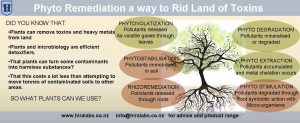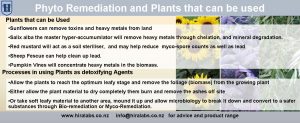Phyto-Remediation
Phyto-Remediation
How many of us have despaired at the contaminated land we have inherited either from previous agricultural, horticultural or industrial activities on our land. This does affect the health of the soil biome and ultimately the grazing animals that are not getting naturally occurring soil born organisms. This leads to an overbloom of mycotoxins, imbalances between various macro-nutrients and soil pH.
WHAT IS PHYTO_REMEDIATION?
PHYTO-REMEDATION. The word PHYTO means PLANT. So phyto remediation refers to the use of PLANTS to rid the land of a range of TOXINS such as:
- Biological for example fungi, bacteria and to some extent viruses.
- Chemical toxins like herbicide, insectide and industrial run off.
- The consequence of industrial and agricultural activities urban and rural areas leading to toxic materials in the ground.
- Heavy metal contamination.
- Radio active waste.
SO WHAT ARE WE TALKING ABOUT?
- A process called PHYTO-REMEDIATION, one of the newest and most promising fields of biology using plants to absorb toxins from the soil as part of their photosynthetic cycle.
- Other methods use mushrooms and fungi in what is called MYCO-REMEDIATION BIO-REMEDATION using bacteria that use a systems to include BIO-SPARGING , BIO-SLURPING and BIO-VENTING to assimilate and ‘detoxify’ areas of land.
HOW IS TOXIC WASTE CURRENTLY REMOVED?
- By mechanical means by removing tonnes of contaminated soil, involving years of work and vast sums of money.
- Disposal of contaminated soils of site moves the problem elsewhere.
- Currently there is no effective means of turning toxins onto something harmless or to concentrate them in something lightweight and removable.
THE PHYTO-REMEDATION ALTERNATIVE
- Plants are natural devices costing nothing to create, with the ability to dupilcate themselves. Exponentially
- Plants are sustainable performing several beneficial functions simaltaneously; absorb CO2, prevent soil erosion, provide bee fodder, shade, beauty, a home for wildlife, and possibly firewood.
- Plant and microbiology , are capable of absorbing specific chemicals thereby making themselves poisonous to avoid being eaten (in most cases)
- They then photosynthesize them selves into new compounds thereby removing contaminants from the soil absorbing the contaminants into their tissues.
- This process of photosynthesis, respiration and transpiration effectively removes contaminants via a range of conduits to reduce the amount of toxins.
- This multifaceted process gradually cleans the soil.
METHODS IN WHICH PLANTS DETOXIFY SOIL
Phyto volatization Pollutants are released as volatile gases thorough leaves
Phyto stabilisation Pollutants immobilzed in soils
Rhizo remediation Pollutants released by roots and the fungi surrounding them.
Phyto degradation Pollutants mineralised, formed into new compounds or degraded
Phyto extraction pollutants accumulated and metal chelation occurs.
Phyto stimulation pollutants degraded through root symbiotic action with micro-organisms
HOW CAN WE IMPLEMENT THIS ON OUR OWN PROPERTY?
Plants are static and require seasons of conversions to harmless substances, harvesting and removal of biomass , Phyto remediation and the processes of reducing a toxin to safe levels takes time along with successional processes of photosynthesis and transpiration , and phytoremediation doesn’t remove a problem overnight.
- Firstly identify what toxins are present
- Then decide on a plant matrix that hyper-accumulate those particular toxins. ( see list later)
- Prepare the site making it suitable for either plug planting, putting in rooted cuttings like willow or sowing seed ie mustard lupins, hemp . Ensure the soil is well tilled and free of weeds.
- Plant choice will be determined by what will grow well in the site and exactly which contaminants you wish to remove.
- Look at existing conditions and use plant species most suited to the area
CATEGORIES OF TOXINS YOU MAY ENCOUNTER
The more common categories include: metals, petrochemicals and biological.
1 PETROCHEMICAL
- Petrochemicals generally have familiar atoms like C (carbon),H (hydrogen) and O (oxygen), the same things that make up foods like potatoes pastas etc, flower , various hormones, esotrogens, newspaper, to name a few.
- Petrochemical CHO form combinations, to make compounds like gasoline, or lethal poisons — determined by how the three atoms CHO are arranged and in what number are put together
- A plant may be able to absorb any cancer-causing benzine/petroleum and turn this poison into a safe combination of CHO (some form of glucose or similar)
2 METAL
- When the toxins are metals, of course, they cannot be broken down into other elements ie copper to gold or zinc to lead.
- Some plants can absorb the metal and metabolise it into some kind of molecule, which is less easy to be absorbed by the body. Sometimes the metals are able to be to accumulated and used as supplements ie zinc from contaminated soils to provide a bio-supplement to address a zinc deficiency.Chamomile is a magnesium accumulator.
- After the plants are harvested with the metals concentrated in their tissues.
- They are then burned with the metal and toxins remaining in the ash – this ash (much reduced volume of biomass) is then collected and either piled in a ‘safe/contained ‘ area or taken off site.
- This process should be repeated for a few seasons to ensure complete removal of toxins.
3 BIOLOGICAL
- These occur when the soil biology is poor and lacking in diversity that may out compete pathogens.
- An overbloom of pathogens ie fungi, bacteria and in some cases viruses.
- While plants may be used the process of MYCO-REMEDIATION may be preferable
SO WHAT PLANTS CAN BE USED?
- Generally those plants that convert sunlight, water and CO2 efficiently to produce large quantities of biomass in their foliage.
- Sunflowers can remove toxins and heavy metals from land
- Salix alba the master hyper-accumumlator will remove heavy metals through chelation, and mineral degradation.
- Red mustard will act as a soil steriliser, and may help reduce myco-spore counts as well as lead
- Sheep Fescue can help clean up lead.
- Pumpkin Vines will concentrate heavy metals in the biomass.
- Allow the plants to reach the optimum leafy stage and remove the foliage (biomass) from the growing plant
- Either allow the plant material to dry completely them burn and remove the ashes off site
- Or take soft leafy material to another area, mound it up and allow microbiology to break it down and convert to a safer substances through Bio-remediation or Myco-Remediation.
- Mustard greens were used to remove 45% of the excess lead from a yard in Boston to ensure the safety of children who play there.
- Pumpkin vines were used to clean up an old Magic Marker factory site in Trenton, New Jersey, while
- Alpine pennycress helped clean up abandoned mines in Britain.
- Hydroponically grown sunflowers were used to absorb radioactive metals near the Chernobyl nuclear site in the Ukraine as well as a uranium plant in Ohio.
- Blue Sheep fescue helps clean up lead, as do water ferns and members of the cabbage family Brassicaes. .
- Smooth water hyssop takes up copper and mercury,
- Water hyacinths suck up mercury, lead, cadmium, zinc, cesium, strontium-90, uranium and various pesticides.
- Sunflowers take in a wide range of compounds – not just the uranium and strontium-90 from radioactive sites, but also cesium, methyl bromide and many more.
- Bladder campion accumulates zinc and copper, while Indian mustard greens concentrate selenium, sulphur, lead, chromium, cadmium, nickel, zinc, and copper.
- Perhaps the most magnificent hyperaccumulator, though, is the simple willow tree, Salix viminalis; it slurps up copper, zinc, cadmium, selenium, silver, chromium, uranium, petrochemicals and many others. Also, once its bio-mass has concentrated the heavy metals, it can be harvested and used for a range of things other than feed.
A bit more on phtyo-remediation. I believe that it may be possible for the 5meter riparian strip on either side of rivers and water ways could be planted with plants that will provide an interface between grazing land and its run off and a water course. Nitrates and nitrites
SOME ADDITIONAL POINTS ON REDUCING HIGH NITROGEN LEVELS
- Using Plants to remove excess nitrogen in soil, you need to bind the nitrogen that is in the soil to something else.
- While most plants will bind nitrogen, plants like pumpkin, cabbage, broccoli, mustard and corn use up excess nitrogen while growing. Be aware that the, plants may look sickly, or send up excess leafy matter and will not produce many fruits or flowers or be suitable as animal fodder..
- In this way plant in particular tall leafy plants act as sponges that will help lower soil nitrogen content.
- Mulch for may used to deplete nitrogen as it breaks down by laying it over the soil in particular wood and bark chips will act as a sponge and converter through volatisation when spread over the surface. .
- This could again be used along the 5m strip o kick start the process and in turn will create a humus sponge that will grow species to further remediate the land.


